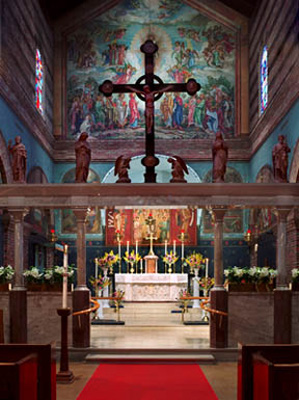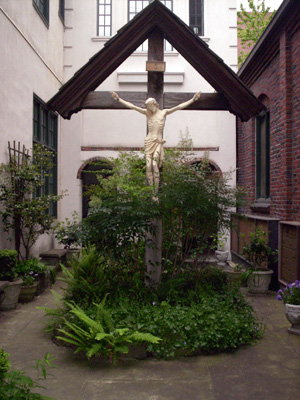 |
||||||||||
 |
||||||||||
|
1331: St Mark's, Portland, Oregon, USA Mystery Worshipper: Abed-Nego. The church: St Mark's, Portland, Oregon, USA. Denomination: Anglican Church in America. The building: The present red brick building dates from the early 20th century and is in the Romanesque style, reminiscent of the great Italian basilicas. One's eye is immediately drawn toward the sanctuary and the high altar, where several large murals depict the Ascension and Christ the Great High Priest. Equally dramatic is the rood screen where reside a number of Venetian statues donated in 1911 by a certain Miss Percival, sister of the noted Anglo-Catholic clergyman Henry R. Percival, rector of the Church of the Evangelists in Philadelphia. When that church closed, Miss Percival removed her residence and her substantial wealth to Portland, where she instituted a golden age of catholic worship in her adopted city. Her memorial is the rose window installed by the Connick Studios of Boston, whose work also adorns Grace Cathedral in San Francisco and St Clement's Church in Philadelphia. Between the church building and the parish hall is a beautiful Calvary garden featuring a life-size crucifix. The church: I invariably look for the oddball or memorable when answering this question, but found the congregation to be very sociable and welcoming, comprised of middle-aged and up, middle class, white people. On January 17, 1993, the parish officially withdrew from the Episcopal Church and affiliated itself with the Anglican Church in America (ACA). The Rev. Charles H. Osborn, who had served as rector from 1962 to 1974 and had helped found the ACA, returned to serve as interim priest-in-charge until a new rector could be called. The neighborhood: Portland is Oregon's largest city and enjoys a climate marked by warm summers and rainy but temperate winters – perfect for roses. Visitors to a convention of the Episcopal Church held in 1888 dubbed Portland "the city of roses." A few years later, the first Portland Rose Festival was held, and has been held each June ever since. I suspect that this neighborhood has come up in the world since the time when St Mark's was built. It fairly bristles with life. Coffee bars, upscale restaurants and fascinating shops abound, and students and young families fill the sidewalks. Lots of energy! Amazingly there are no fast-food franchises. The cast: The celebrant was the Rev. W.S. Herb, curate. Serving as deacon was the Rev. M.D. Lillegard, SSC, rector, and the subdeacon was Mr Charles Hart III. Music director was Mr Luke Woods. The date & time: Twelfth Sunday after Trinity, September 3, 2006, 10.00am. What was the name of the service? High Mass. How full was the building? I'd say about half full, about 60 people, with everybody scattered around pretty evenly. Did anyone welcome you personally? Yes. A charming lady greeted us even before we were through the door, and pointed in the direction of an equally charming man who handed us a slim library of liturgical pointers. (More on that to come...) Was your pew comfortable? Perfectly satisfactory in every way. How would you describe the pre-service atmosphere? Quiet and reverential, though it felt as if everyone arrived just moments before the service began. What were the exact opening words of the service? "Thou shalt purge me O Lord, with hyssop, and I shall be clean" – the opening words of the Asperges. What books did the congregation use during the service? The Book of Common Prayer 1928; The Hymnal 1940; People's Missal; plus an order of service that contained the propers, the hymn numbers and the scripture readings as well as the weekly schedule of masses. There was also a different order of service containing a breakdown of the mass, along with page numbers for the various sections as located in the Book of Common Prayer plus hymn numbers for those parts of the mass that were going to be sung congregationally. And then there was a sheet of paper telling us who donated the flowers, whose birthday or anniversary would occur during the week, announcements about religious education classes, and advance notice of upcoming feasts. On another sheet was given the music for the Asperges and for the responses to be sung between each of the Ten Commandments. Then there was a flyer forewarning us that four weeks from now would be the time for the parish Michaelmas feast. We were advised to "bake our pumpkin pies, roast the goose and bake the apples." A final leaflet gave us an update on the organ fund, along with a request for donations to "replace the solenoids in the brustwerks." This last leaflet also repeated information about the religious education classes and broke the news that there would be a saint of the day discussion group every Thursday after the noon mass (bring a bag lunch). But enough! I'll have more to say about all of this in the hellish bits below. What musical instruments were played? A most excellent organ, played by someone who knew how to play it. The fine Werner-Bosch tracker-action organ was dedicated in 1966. Did anything distract you? I couldn't get over how ill-matched the green of the altar frontal was with the green of the celebrant's chasuble. The altar was a muted sage whereas the vestment bordered on the emerald. Ouch! Was the worship stiff-upper-lip, happy clappy, or what? High church Anglo-Catholic was the order of the day – though there was only one chasuble in evidence, and I don't think I saw any birettas until the greeting line at the end of mass.  Exactly how long was the sermon? 7 minutes. On a scale of 1-10, how good was the preacher? 8 – Father Lillegard took only two words from the Gospel of the day and very effectively connected them with five words from the day's Epistle reading. In a nutshell, what was the sermon about? Mark's Gospel tells us that as Christ was about to heal the deaf man at Decapolis, he looked up to heaven and sighed. Why do we think that Jesus sighed? Was it because the deaf man would be distracted by the miracle and miss the message? In 2 Corinthians, St Paul reminds us that our sufficiency is of God. God will bring us to the fulfillment of Christ's promise; he does not want us to be mere puppets. The existence of free will may bring about war, sickness and sin, but it also strengthens our spiritual muscles. Our Lord sighed because he knew that many will miss that message. Which part of the service was like being in heaven? I have always considered Episcopalians to inclusive and tolerant of differences in their ranks, but even so I had to respect the fact that these good Christian people had been prepared to go to very great lengths to uphold their most dearly-held beliefs. They had broken with the Episcopal Church because they felt that they must maintain their firmly-held and much-loved traditions – even if it meant severing their historic roots. I would find that hard to do, and I admire such tenacity. And which part was like being in... er... the other place? For all the literature we were handed, we learned nothing about the organ prelude and postlude or the communion anthem – and we had no notion who would sing it! And some of the handouts were in conflict with others. The Asperges/Decalogue leaflet, for example, was musically inaccurate. We were embarrassed to be singing musical notes that were at considerable variance to everyone else's! I'm not very retiring when it comes to joining in communal singing. (Some of my British friends would definitely say I give it "the full welly"!) And I'm a good reader when it comes to music. So there was something distinctly hellish about singing the wrong notes in the right places with quite such confidence and self-assurance. And did we really need to have a half dozen publications in hand to get through the service, with not one of them being definitive? What happened when you hung around after the service looking lost? We were warmly welcomed in the greeting line, and invited to join everyone in the church hall for coffee and refreshments. How would you describe the after-service coffee? Everyone was a bit self-absorbed, but we did break the ice with the lady serving the coffee, and one introduction led to another. How would you feel about making this church your regular (where 10 = ecstatic, 0 = terminal)? 9 – It would be 10 if it wasn't for that breach with ECUSA. Did the service make you feel glad to be a Christian? Of course! What one thing will you remember about all this in seven days' time? The beauty of the Calvary garden between the church and the hall. |
|
|
||||||||||||||||||||||||||||||||||||
| More Mystery Worshipper reports | |||||||||||||||||||||||||||||||||||||||
 |
|||||||||||||||||||||||||||||||||||||||






